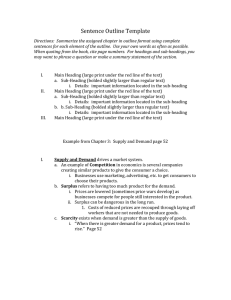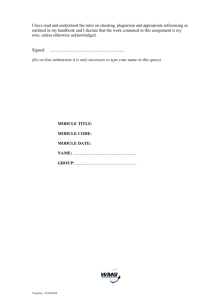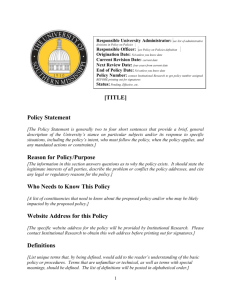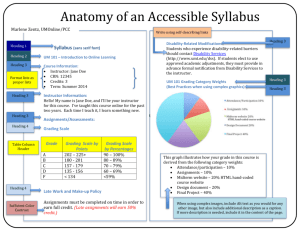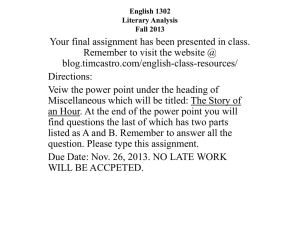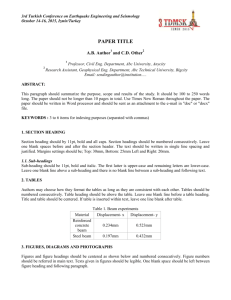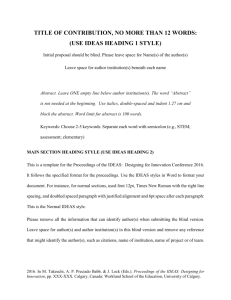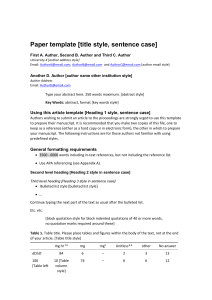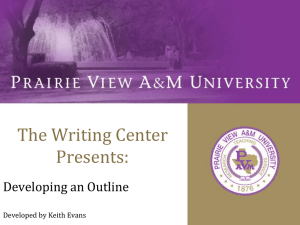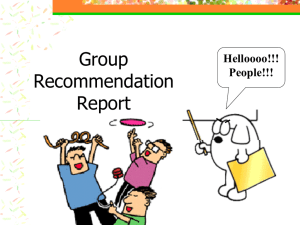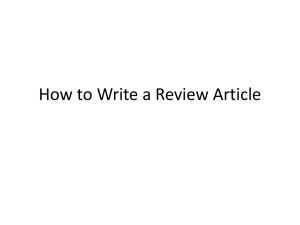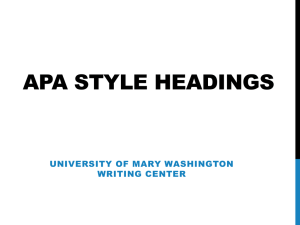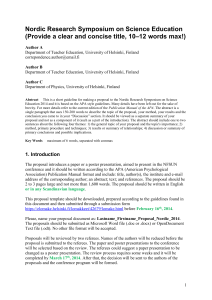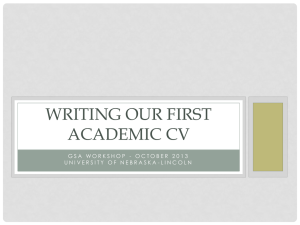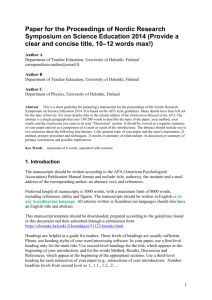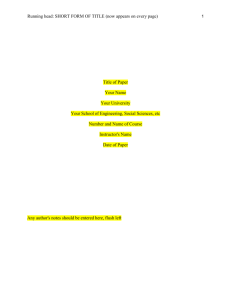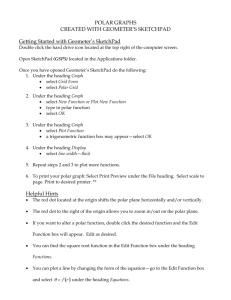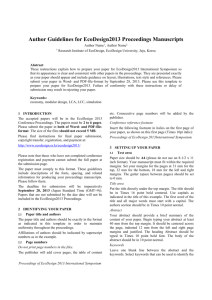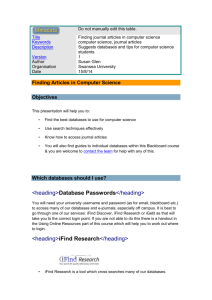1. Styles
advertisement
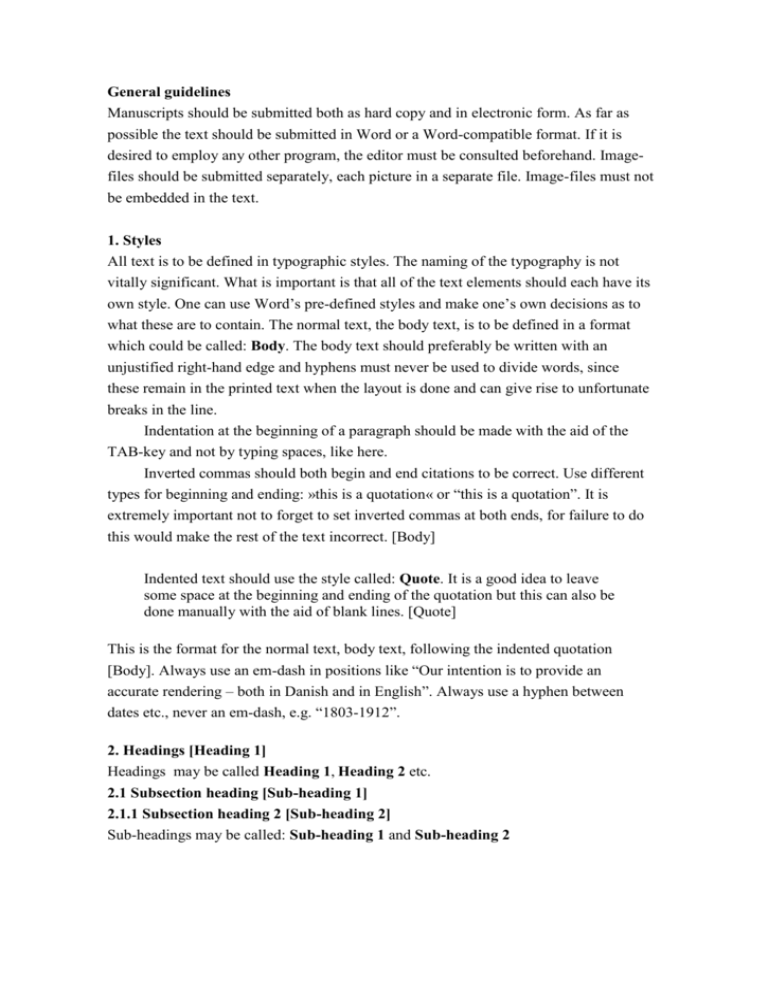
General guidelines Manuscripts should be submitted both as hard copy and in electronic form. As far as possible the text should be submitted in Word or a Word-compatible format. If it is desired to employ any other program, the editor must be consulted beforehand. Imagefiles should be submitted separately, each picture in a separate file. Image-files must not be embedded in the text. 1. Styles All text is to be defined in typographic styles. The naming of the typography is not vitally significant. What is important is that all of the text elements should each have its own style. One can use Word’s pre-defined styles and make one’s own decisions as to what these are to contain. The normal text, the body text, is to be defined in a format which could be called: Body. The body text should preferably be written with an unjustified right-hand edge and hyphens must never be used to divide words, since these remain in the printed text when the layout is done and can give rise to unfortunate breaks in the line. Indentation at the beginning of a paragraph should be made with the aid of the TAB-key and not by typing spaces, like here. Inverted commas should both begin and end citations to be correct. Use different types for beginning and ending: »this is a quotation« or “this is a quotation”. It is extremely important not to forget to set inverted commas at both ends, for failure to do this would make the rest of the text incorrect. [Body] Indented text should use the style called: Quote. It is a good idea to leave some space at the beginning and ending of the quotation but this can also be done manually with the aid of blank lines. [Quote] This is the format for the normal text, body text, following the indented quotation [Body]. Always use an em-dash in positions like “Our intention is to provide an accurate rendering – both in Danish and in English”. Always use a hyphen between dates etc., never an em-dash, e.g. “1803-1912”. 2. Headings [Heading 1] Headings may be called Heading 1, Heading 2 etc. 2.1 Subsection heading [Sub-heading 1] 2.1.1 Subsection heading 2 [Sub-heading 2] Sub-headings may be called: Sub-heading 1 and Sub-heading 2 3. Chapters Chapter 1 [Chapter] If there is to be a chapter start as shown here, the format to be used should be called: Chapter. The chapter heading itself should be called for instance: Chapter heading Chapter heading [Chapter heading] 4. Footnotes Notes should normally be placed as footnotes,1 not as endnotes. 5. Illustrations If there are illustrations or similar matter, indication should be given in the manuscript as to the approximate place where the illustration should be placed. Images should not be embedded in the text file, but be submitted separately, each picture in a separate file. The images must have a resolution of a minimum of 300dpi to be suitable for printing. Many of the files that can be retrieved from the net have a far too low resolution and although they can function satisfactorily in a PowerPoint presentation, they are useless for printing. 6. Captions under images The captions under the images should use the style called: Caption and they can be submitted either in a separate file or inserted in the text together with an indication as to where the image is to be placed. 7. Tables and figures Tables are to be set up in Word’s table-function so that they can be converted automatically. The text in the table should be in a style called: Table text [Table text] [Table text] [Table text] [Table text] [Table text] [Table text] Table 1. An example of a table [Caption]. 8. Bibliography Bibliographies, lists of references etc. should be in accordance with accepted practice within the particular field of research. They are to be defined in the style called Bibliography. Olson, Elder: The Theory of Comedy, Bloomington/London: Indiana University Press 1968. Ostenfeld, Ib: Angst-Begrebet i Søren Kierkegaards: Begrebet Angst [sic!]. En psykologisk Detail-Studie, København: Gad 1933. 1 This is a footnote. [Footnote] Otani, Masaru: “Om det Komiske i Kierkegaards Efterskrift”, i Kierkegaardina, bd. 5, 1964, pp. 68-77. Otani, Masaru: “The Comical”, i N. Thulstrup & M.M. Thulstrup (udg.): Concepts and Alternatives in Kierkegaard, København: C.A. Reitzel 1980 (Bibliotheca Kierkegaardiana, bd. 3), pp. 229-235. [Bibliography] Always use an em-dash when a surname is repeated in such a position. Always use a hyphen between dates, page-numbers etc., never an em-dash. 9. Index, key words Key words are to be marked with Word’s index function and can be automatically converted. Remember! If there is more than one index, these should be marked as different indices. 10. Abstract An abstract in English is required. It should be of 10-15 lines, outline main features, stress novel information and conclusions, and end with the author’s name, title, and institutional and/or private postal address. Use the style Abstract. [Abstract]

